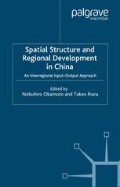Abstract
Over the past two decades, China’s economic development has been characterized as market-oriented reform. As part of a process of opening up to the outside world under the philosophy of the ‘Step Ladder Development Policy’, the coastal region, especially the south, enjoyed preferential economic policies and has achieved faster rates of economic growth than the Non-coastal regions. The Chinese government hopes that this will be a learning curve and provide the experience to introduce economic reforms to the interior regions, and, simultaneously, that the faster development of the coastal region could pass on to the other regions. While China is on a rapid growth path, there has been increasingly unbalanced regional development, particularly since the 1990s. As in the case of other large-scale economies, the Coastal (eastern) region of China grows much faster than the Non-coastal (western or interior) region, while the eastern region is much smaller than the western region. In order to develop the western region, in 1999 the Chinese government introduced a ‘Western Area Development Strategy’. The regional development problem has become an important issue, and the study of the influence and interdependence of regional economies is becoming increasingly urgent.
Access this chapter
Tax calculation will be finalised at checkout
Purchases are for personal use only
Preview
Unable to display preview. Download preview PDF.
References
Batten, D.F. and D. Martellato (1988) ‘Modelling Interregional Trade with Input-Output Systems’, Richerche Economiche, 42(2), 204–21.
Brun, J.F., J.L. Combes and M.F. Renard (2002) ‘Are the Spillover Effects Between Coastal and Noncoastal Regions in China?’, China Economic Review, 13, 161–9.
Charnes, A. and W.W. Cooper (1961) Management Models and Industrial Applications of Linear Programming, vol. 1. New York: Wiley.
Dietzenbacher, E. (2002) ‘Interregional Multipliers: Looking Backward, Looking Forward’, Regional Studies, 36(2), 125–36.
Dietzenbacher, E. and J.A. van der Linden (1997) ‘Sectoral and Spatial Linkages in the EC Production Structure’, Journal of Regional Science, 37(2), 235–57.
Gillen, W.J. and A. Guccione (1980) ‘Interregional Feedbacks in Input-Output Models: Some Formal Results’, Journal of Regional Science, 20(4), 477–82.
Greytak, D. (1970) ‘Regional Impact of Interregional Trade in Input-Output Analysis’, Papers Regional Science Association, 25, 203–17.
Greytak, D. (1974) ‘Regional Interindustry Multipliers: An Analysis of Information’, Regional and Urban Economics, 4, 163–72.
Guccione, A., W.J. Gillen, P.D. Blair and R.E. Miller (1988) ‘Interregional Feedbacks in Input-Output Models: The Least Upper Bound’, Journal of Regional Science, 28(3), 397–404.
Liew, C.K. and C.J. Liew (1985) ‘Measuring the Development Impact of a Transportation System: A Simplified Approach’, Journal of Regional Science, 25, 241–57.
Lundqvist, L. (1981) ‘Applications of A Dynamic Multiregional Input-Output Model of the Swedish Economy’, Papers Regional Science Association, 47, 79–95.
Miller, R.E. (1963) ‘Comments on the “General Equilibrium” Model of Professor Moses’, Metroeconomica, 40, 82–8.
Miller, R.E. (1966) ‘Interregional Feedback Effects in Input-Output Models: Some Preliminary Results’, Papers of the Regional Science Association, 17, 105–25.
Miller, R.E. (1969) ‘Interregional Feedback Effects in Input-Output Models: Some Experimental Results’, Western Economic Journal, 7, 41–50.
Miller, R.E. (1986) ‘Upper Bounds on the Sizes of Interregional Feedbacks in Multiregional Input-Output Models’, Journal of Regional Science, 26(2), 285–306.
Miller, R.E. (1998) ‘Regional and Interregional Input-Output Analysis’, as chapter 3 in W. Isard, I.J. Azis, M.P. Drennan, R.E. Miller, S. Saltzman and E. Thorbecke, Methods of Interregional and Regional Analysis, Aldershot: Ashgate, pp. 41–124.
Miller, R.E. and P.D. Blair (1985) ‘Input-Output Models at the Regional Level’, In Input-Output Analysis: Foundations and Extensions, Englewood Cliffs, NJ: Prentice-Hall, pp. 45–99.
Poncet, S. (2001) ‘The Magnitude of Chinese Provinces’ Internal and Interregional Trade Integration. Is Chinese Provinces’ Greater International Openness Threatening China’s Domestic Market Integration?’, paper presented at the 3rd International Conference on the Chinese Economy, Has China Become Market Economy? CERDI (le Centre d’études et de recherches sur le développement international), Clermont-Ferrand, France.
Pyatt, G. and J.I. Round (1979) ‘Accounting and Fixed Price Multipliers in a Social Accounting Matrix Framework’, The Economic Journal, 89, 850–73.
Round, J.I. (1985) ‘Decomposing Multipliers for Economic Systems Involving Regional and World Trade’, The Economic Journal, 95, 383–99.
Round, J.I. (2001) ‘Feedback Effects in Interregional Input-Output Models: What Have We Learned?’, in M.L. Lahr and E. Dietzenbacher (eds), Input-Output Analysis: Frontiers and Extensions, New York: Palgrave, pp. 54–78.
Sonis, M. and G.J.D. Hewings (1999) ‘Miyazawa’s Contributions to Understanding Economic Structure: Interpretation, Evaluation and Extensions’, in G.J.D. Hewings, M. Sonis, M. Madden and Y. Kimura (eds), Understanding and Interpreting Economic Structure: Essays in Honour of Kenichi Miyazawa, Heidelberg: Spring-Verlag, 13–51.
Sonis, M. and G.J.D. Hewings (2001) ‘Feedbacks in Input-Output Systems: Impacts, Loops and Hierarchies’, in M.L. Lahr and E. Dietzenbacher (eds), Input-Output Analysis: Frontiers and Extensions, New York: Palgrave, pp. 71–99.
Sonis, M., J. Oosterhaven and G.J.D. Hewings (1993) ‘Spatial Economic Structure and Structural Changes in the EC: Feedback Loop Analysis’, Economic Systems Research, 5, 173–84.
Zhang, Q. and B. Felmingham (2002) ‘The Role of FDI, Exports and Spillover Effects in the Regional Development of China’, The Journal of Development Studies, 38(4), 157–78.
Editor information
Editors and Affiliations
Copyright information
© 2005 Institute of Developing Economies (IDE), JETRO
About this chapter
Cite this chapter
Zhang, Y., Zhao, K. (2005). The Spillover and Feedback Effects between Coastal and Non-coastal Regions. In: Okamoto, N., Ihara, T. (eds) Spatial Structure and Regional Development in China. IDE-JETRO Series. Palgrave Macmillan, London. https://doi.org/10.1057/9780230524163_9
Download citation
DOI: https://doi.org/10.1057/9780230524163_9
Publisher Name: Palgrave Macmillan, London
Print ISBN: 978-1-349-52210-1
Online ISBN: 978-0-230-52416-3
eBook Packages: Palgrave Economics & Finance CollectionEconomics and Finance (R0)

